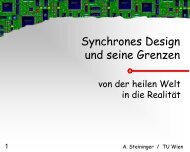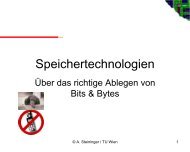Introduction to Microcontrollers
Introduction to Microcontrollers
Introduction to Microcontrollers
You also want an ePaper? Increase the reach of your titles
YUMPU automatically turns print PDFs into web optimized ePapers that Google loves.
2.4. ANALOG I/O 41<br />
The oscillation depends on R and C as well as on your choice of period; Figure 2.13 greatly<br />
exaggerates the effect. To reduce the amount of oscillation, either make R and C larger (at the cost of<br />
a longer stabilization time) or use a shorter period.<br />
Disadvantages of using PWM are that you require a dedicated timer <strong>to</strong> generate the PWM signal<br />
and that you need <strong>to</strong> wait for a few periods until the output signal stabilizes. As an advantage, the d/a<br />
converter only uses up one single output pin.<br />
A different way <strong>to</strong> achieve d/a conversion is <strong>to</strong> use a binary-weighted resis<strong>to</strong>r circuit, see Figure<br />
2.14. Here, we have an r-bit input which is converted in<strong>to</strong> the appropriate analog output. To this<br />
aim, each bit of the binary input switches its path between Vref and GND. The output voltage of the<br />
circuit (for no output load) is given by<br />
Vo = Vref ·<br />
r�<br />
i=1<br />
where (br−1 · · · b0)2 is the digital value <strong>to</strong> be converted.<br />
b r−1<br />
b 1<br />
b 0<br />
R/2 r−1<br />
.<br />
R/2<br />
R<br />
1<br />
2 i br−i , (2.2)<br />
Figure 2.14: Digital-<strong>to</strong>-analog conversion based on a binary-weighted resis<strong>to</strong>r circuit.<br />
The main disadvantage of the binary-weighted resis<strong>to</strong>r circuit is that it requires many different<br />
resis<strong>to</strong>r types with have <strong>to</strong> be high precision <strong>to</strong> keep the ratio correct. This is hard <strong>to</strong> achieve. As an<br />
alternative, an R-2R resis<strong>to</strong>r ladder can be employed, see Figure 2.15.<br />
This type of DAC has the advantage that it only requires two types of resis<strong>to</strong>rs, R and 2R. The<br />
output voltage of the ladder circuit is again given by Equation 2.2.<br />
2.4.2 Analog Compara<strong>to</strong>r<br />
The simplest way <strong>to</strong> deal with analog inputs in a microcontroller is <strong>to</strong> compare them <strong>to</strong> each other<br />
or <strong>to</strong> a known reference voltage. For example, the pho<strong>to</strong>transis<strong>to</strong>r we mentioned previously could<br />
be used <strong>to</strong> implement a twilight switch, turning on a light whenever its output voltage indicates that<br />
the ambient light level is below some threshold. For such purposes, some microcontrollers which<br />
R<br />
V o













